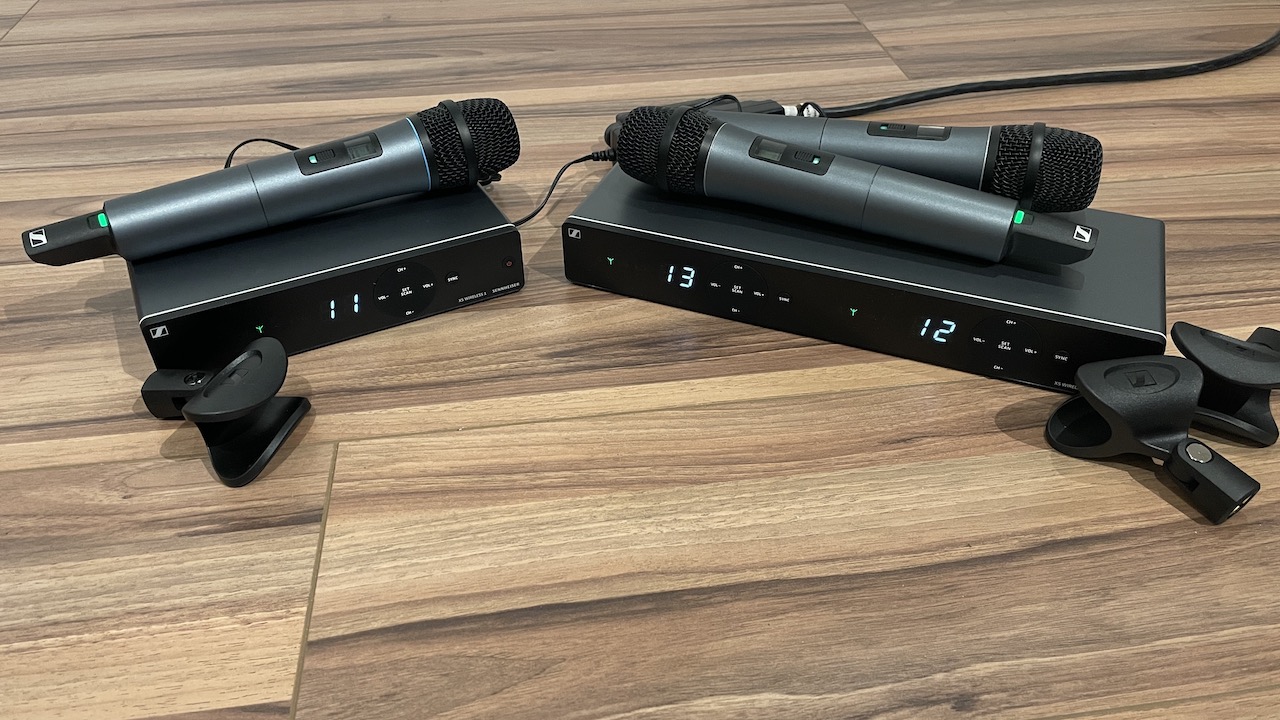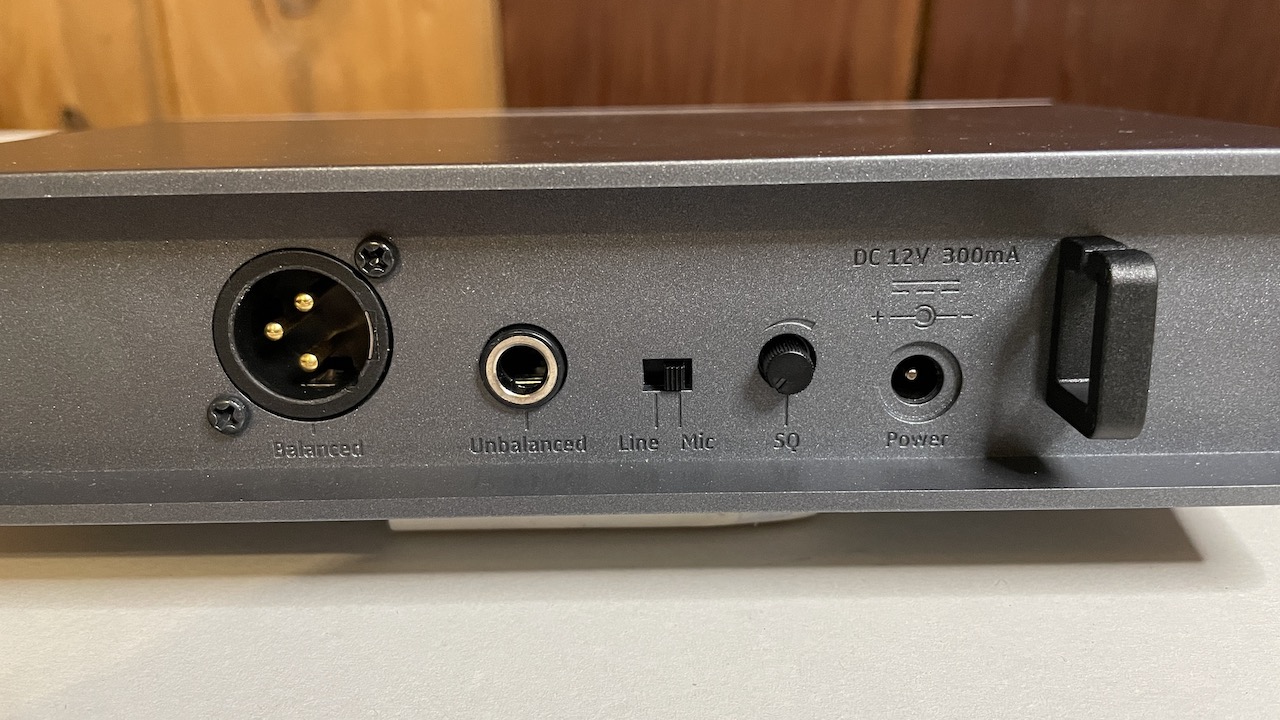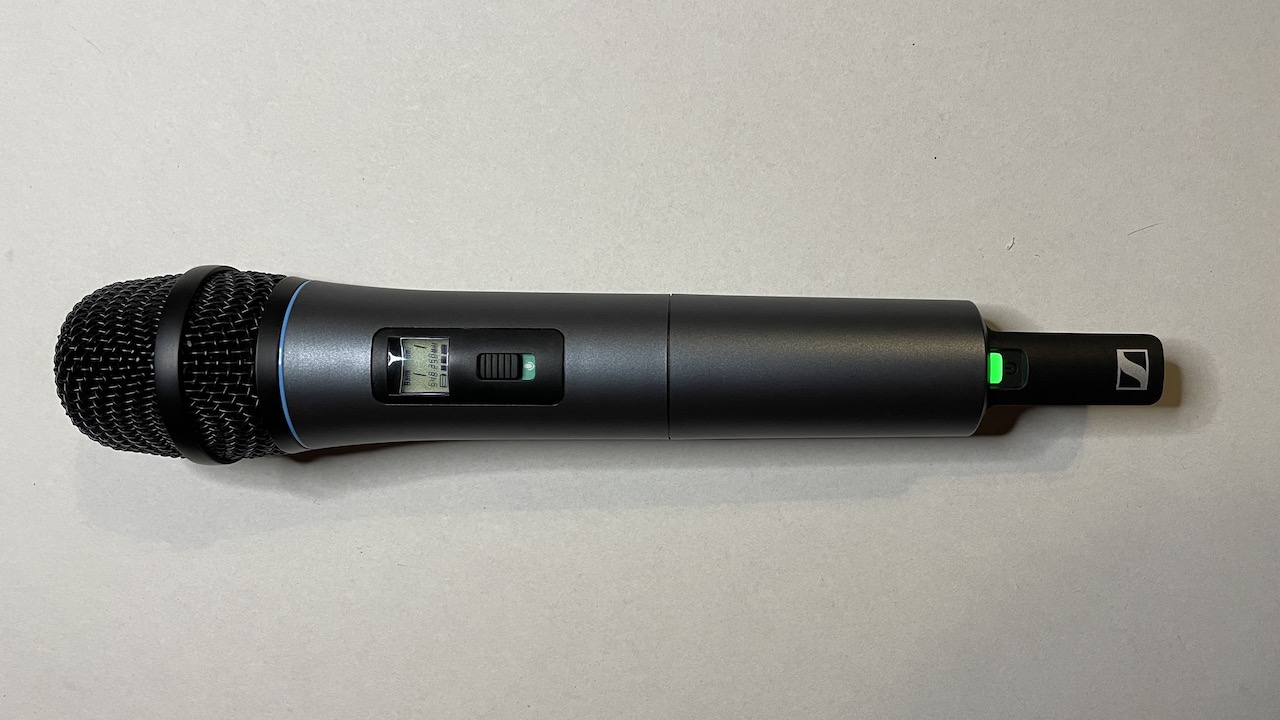
Today, I will review two of Sennheiser’s wireless microphone sets—the single channel XSW 1-825-A and dual channel XSW 1-835 DUAL-A. Sennheiser is a leader in wireless audio technology. Their microphones are among the go-to options for performers and sound technicians. These two sets contain very similar elements and offer home recording artists and live performers freedom and reliability on stage or in the home studio. I give you my opinion on the build quality and sound of the E825 microphone, as well as the wireless receiver, in my video and written review below.
Features of the single and dual channel microphone sets
The XSW 1-825-A and dual XSW 1-835 DUAL-A are very similar products. The main difference between the two is the addition of a second microphone and a second channel on the transmitter for the dual product. Note that most of the aspects I review for the single wireless microphone apply to the dual product as well.
These microphone sets sport standard wireless microphone features and are extremely easy to set up and use. The simplicity of the installation and use make the kits an appealing choice for live sound applications.
Here is a list of the Sennheiser XS Wireless sets’ features:
- Integrated antennas—no external “rabbit ears”
- Automatic frequency management
- Diverse reception
- Evolution E825/E835 dynamic microphone capsule
- Range of up to 75 meters (250 ft.) under optimal conditions
Unboxing and set up
Inside the box of the microphone sets, I find a simple display of all the equipment I need to test out the unit. In the regular single channel set, I find the E285 wireless microphone, the EM-XSW1 receiver, a power adapter (with international plugs for worldwide use), a microphone clip for each wireless microphone, and AA batteries for each mic as well.
In the 2-channel set, Sennheiser includes the slightly more robust E835 capsule in two microphones. The E835 capsule also has a slight frequency boost at 3 – 5kHz, which makes the mic a better choice for singing situations—think Karaoke duets!
I am impressed with how easy it is to set up the XS Wireless 1 microphone system. With just four steps, I am ready to go.
- Connect the power adapter to the receiver
- Connect an XLR cable from the receiver to the sound console
- Put the 2 AA batteries in the microphone
- Turn on the microphone, and you have sound!
The system is so effortless to set up, I can see that is usable in many contexts. Everything I need is intuitive to use and clearly labelled, meaning this wireless microphone kit truly is a good choice for many different types of users. From conferences to karaoke, to live music or community gatherings, both wireless microphone systems require minimal technical expertise.
XS Wireless 1 receiver features
My first impression is that the 1-channel wireless receiver is extremely light! This is a great attribute if you plan on transporting your wireless microphone setup often. However, I am quick to discover the body of the receiver is made of plastic, which is the reason for its low weight.
There are positives and negatives to plastic construction. Positively, the plastic is lightweight, making the XS wireless system extremely portable. Negatively, plastic generally is not very durable over time. Absent is any sort of rack-mounting system or carrying case. You would need to take good care of the receiver if you intend to transport this system often. I recently reviewed the Sennheiser XSW 2-835-A Wireless Vocal Set, a professional-level set where the XS Wireless 2 receiver has a metallic build, and the difference in quality is obvious.
Front panel is simple and practical

The receiver’s front panel provides a simple layout with all the basic information on the functioning of the XS Wireless microphone set. From the left, four small lights indicate the status of the unit: Signal, Antenna, SYNC mode, and Battery level. The battery level indicator is fantastic. It helps sound technicians foresee mic drop-outs from dead batteries.
Further along, the XS wireless receiver also has a nice big number display for the Bank and Channel routing. This display also serves to indicate the volume output of the receiver. The volume ranges from 0-9 and adjusts the amount of signal being sent forth to the sound system.
Next is the control panel. The operations are clearly labelled for manually adjusting channel and volume. The channels are scan-able to help find the best reception if needed, and there is a Sync button as well that helps when using multiple units. It is easy for me to navigate these features using the controls. I set the volume to ‘8’, which provides a healthy amount of audio signal to my system.
Back panel connection ports

The rear panel of the wireless receiver contains a simple array of connections and switches. Here I find an XLR balanced connection and a 1-4″ unbalanced connection. Next, a switch for Line or Mic allows adjusting the output level of the unit based on the requirement of the moment. The rear panel is also where I connect the included DC power supply.
One final feature of the back panel is a Squelch (SQ) adjuster. Adjusting the SQ suppresses the point at which small noises that come from the microphone are audible. Think of it as the threshold at which the microphone mutes unwanted channel noises or even little “pops” that can sometimes occur. The squelch feature needs to be set manually but is very useful when well-managed.
E825 microphone features
The Sennheiser 1-channel and 2-channel vocal sets feature a dynamic wireless microphone. The E825 comes with the 1-channel set and is intended mainly for speaking situations. The 2-channel set features two E835 microphones, which have a slight boost in the 3kHz – 5kHz range that allows for better presence for singing applications.

Each mic balances well in my hand, and I feel like it would be easy to hold it for longer periods of time. The overall weight is slightly less than other dynamic microphones in my collection, which is due to the plastic casing. However, there is a metal framework beneath the plastic casing. My usual concern is that plastic is not durable over time. I feel this is less concerning with the E825 and E835 microphones because of the internal metal build.
Dynamic capsule gives a confident balanced sound
Using the microphone is very easy. With a simple click of the power switch and the activation of the mute/unmute button I am able to hear my voice. And my voice sounds great! For the low tone of my voice, I find the E285 and E385 dynamic capsules to be warm and rich. Speaking into the microphone feels natural and confident, with the additional freedom of knowing that I am wireless!
Reception is excellent
The real test of these microphone sets is the reception and sound quality. I am doing these tests from my home studio, which is full of impediments to good wireless sound transmission and reception. I expected quite a few dropouts, but I am very pleasantly surprised to find very few issues.
The signal from the microphones is strong and clear. I hear the occasional scratchy noise, but I have a strong feeling that this can be managed via the SQ “Squelch” feature. Regardless, my tests are in less-than-ideal environments. There is no reason to suspect, under optimal conditions, to have anything less than excellent quality sound transmission.
SYNC function is easy and fantastic
The Sync function of both the 1-channel and 2-channel units becomes very useful. Because I was using the units side-by-side, the 1-channel and 2-channel receivers both start broadcasting on “Channel 1, Bank 1”. I had to reconfigure one of the channels, but this won’t be an issue when using just the one unit.
A quick read of the user manual showed that there is a quick process to fix the issue. Using the control of the 1-channel wireless receiver, I changed the settings to “Channel 1, Bank 3”. Next, I press the Sync button on the receiver. A light appears showing me that the receiver is ready to synchronise. Then, I press the Sync button on the microphone, which is discretely found at the bottom of the microphone’s transmitter. Everything syncs up, flawlessly!
Final thoughts
To conclude this review of the single channel XSW 1-825-A and dual channel XSW 1-835 DUAL-A microphone sets, it seems that once again Sennheiser delivers great, accessible quality. These kits contain everything that we need and offer a very simple setup. The sound quality is excellent, the microphone and receiver are lightweight, and adjustments to the broadcasting setup are easy to make. If you are looking for wireless microphones for basic needs, such as conferences, smaller concerts, and live karaoke situations, either of these two vocal sets would make an excellent choice.
Which wireless microphone system best fits your needs? Is it the 1-channel wireless set, or the 2-channel dual wireless set?



